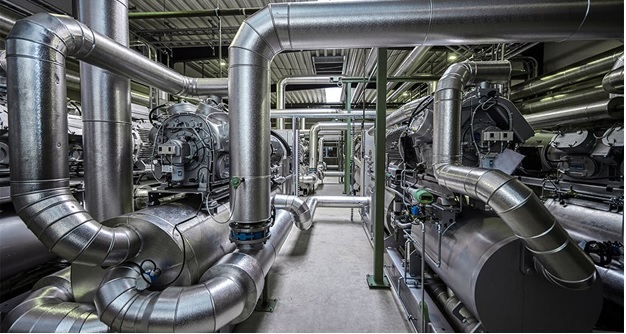The Concept of Industrial Refrigeration
A specialized branch of engineering known as “industrial refrigeration” is dedicated to the freezing and cooling of large-scale industrial processes, machinery, and facilities. This technological advancement is extremely important in various industrial settings, such as the food and beverage, pharmaceutical, and chemical manufacturing industries, where temperature control is crucial to maintaining the quality and safety of the products.
Compared to typical residential or commercial refrigeration systems, the systems used in industrial refrigeration are, for the most part, larger and more complex. Compressors, condensers, evaporators, and control systems are expected to be able to manage demanding cooling procedures and loads. For this system to run effectively, the refrigerants needed are often different from those used in residential and commercial systems because they must necessarily be able operate at a much lower temperatures and be able to effectively handle higher pressures.
Industrial refrigerators are much larger when compared to residential and commercial refrigerators as they are designed for heavy-duty use such as the pharmaceuticals, chemical processing and food production industries as against the commercial refrigerators which are typically smaller and used in restaurants, grocery stores, and convenience stores. Industrial refrigerators are designed to withstand harsh industrial environments and are commonly used to store large quantities of temperature-sensitive products. Owing to this massive demand, industrial refrigerators are frequently equipped with more sophisticated temperature control systems that enable them to maintain exact temperature ranges.
History of Industrial Refrigeration
The history of industrial refrigeration is closely linked to that of contemporary air conditioning technologies. This technology, which has been around for just over a century, has ultimately led to the exponential growth of the chemical manufacturing, pharmaceutical, and food and beverage industries. On the other hand, the idea of refrigeration is more ancient and well-established. Benjamin Franklin invented air conditioners, refrigerators, and refrigerant gases in early 1750 during an experiment using ether in a vacuum to produce a cooling effect. These inventions have continued to develop over time.
Willis Haviland Carrier engineered the first mechanical air conditioner on July 17, 1902, using flammable gases like propane and ammonia as refrigerants. Because of the potential hazards associated with the ammonia and propane used by Willis Haviland Carrier, manufacturers conducted extensive research in 1920 in an effort to introduce safer refrigerants to the market. These studies led to the development of safer and more advanced refrigerants, such as non-flammable hydrocarbons known as chlorofluorocarbons, or CFCs, which are given numerical names according to their chemical compounds.
Up until the 1970s, when it became apparent that CFC refrigerants had significant adverse effects on the environment, the refrigeration and air conditioning industries made extensive use of them. It was found that these gases were entering the atmosphere, where chemical bonds were broken by the sun’s rays, enabling chlorine atoms to act as catalysts to degrade oxygen and ozone molecules. Because of the trapped chlorine in the atmosphere, this depletes the ozone layer. The refrigeration industry gradually switched from using CFC refrigerants to hydro chlorofluorocarbons (HCFCs) and hydrofluorocarbons (HFCs) due to the harm that CFC use caused to the ozone layer. These substances do not, however, come without environmental risks. For this reason, the use of R32 gas, a new, sustainable, and effective refrigerant with a very low GWP (global warming potential), has recently gained popularity.
The Technology and Process behind Industrial Refrigeration System
The basic components of a modern vapor-compression refrigeration system, which are found in the compressor parts; a condenser; an expansion device, which can be a valve, a capillary tube, an engine, or a turbine; and an evaporator, are utilized by the technology powering industrial refrigeration systems. In this system, the gas coolant is pushed into the condenser through a tube after first being compressed—typically by a piston. A portion of the compressed gas’s heat energy is eliminated when the winding tube carrying the vapor is passed through a bath of water or circulating air inside the condenser. After cooling, the vapor is directed through an expansion valve into a region with much lower pressure; during its expansion, the vapor absorbs energy from the surrounding medium or surroundings. Evaporators can work indirectly, that is, by cooling a secondary medium like water, or they can work directly, allowing the vapor to come into contact with the area that needs to be cooled. The evaporator coil in the majority of industrial refrigerators comes into direct contact with air compartment. The process concludes with the hot gas being drawn in the direction of the compressor.



